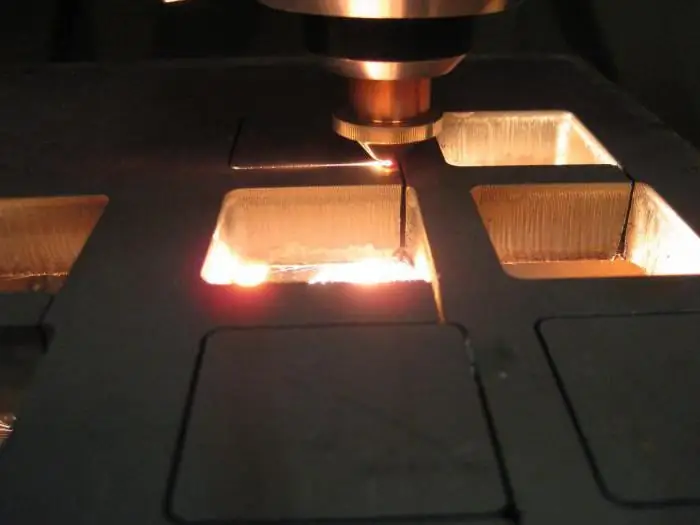2026 Author: Howard Calhoun | [email protected]. Last modified: 2025-01-24 13:10:35
At all times, the textile industry has been one of the most important sectors of the national economy in our country, as it provided the state with a huge amount of much-needed fabric, which was constantly required not only for the production of clothing, but even used in the production of weapons.

And therefore, almost from the first days of the existence of the USSR, chemists were given the task of obtaining artificial tissues, since there was an acute shortage of natural materials. As a result, acetate fiber was created.
What is this?
In fairness, it should be noted that this is not the name of any one specific type of fabric, but several types of artificial fibers at once. In all cases, they are made from cellulose acetate. Triacetyl cellulose fiber is the most common, as well as conventional acetate fiber made from recycled cellulose acetate.
Important qualities of artificial fibers
The hygroscopicity of such fabrics does not exceed 3.5%. The fiber practically does not absorb moisture, does not swell anddoes not sag even after repeated soak/dry cycles. Compared to natural fabrics, artificial fabrics are much less exposed to microorganisms, light and heat. In addition, moths are completely indifferent to them. These fabrics are able to withstand heating up to 100 degrees Celsius without loss of their qualities.
Things made from acetate fibers are very pleasant to look at, wash well and dry quickly. In addition, much less detergent is required when washing them, as dirt is easily washed out of this type of fiber.
Note that weak acids and alkalis do not act on acetate fiber as detrimentally as in the case of natural fabrics, but as a result it is saponified and loses most of its useful qualities. Concentrated inorganic acids destroy it immediately.

Microscopic fiber structure
If you look at such a tissue through a microscope, you can see hundreds of longitudinal grooves on the surface of the fiber. Because of this, the individual threads do not adhere well to each other, and the fabric as a whole is quite elastic and does not wrinkle well. Their brilliance makes them similar in appearance to natural silk, and in terms of thickness, individual fibers are quite similar to the thread that silkworm larvae give out. If the manufacturer is faced with the task of obtaining a fabric in which the threads will be securely linked to each other, then H-shaped transverse cuts are made on the surface of the fibers.
In addition to increased strength, this canvas is characterized by a very beautifulsparkling brilliance, and therefore it is often used for decoration purposes.
Disadvantages of acetate fabrics
Unfortunately, not everything is so good: these types of artificial materials resist abrasion very poorly, pick up static electricity very easily, and do not stain well with standard paints that are commonly used in the textile industry. They should be ironed without raising the temperature of the iron above 115 °, otherwise thermal deformation is possible.
Other negative qualities

Given the very high ability of acetate fiber to accumulate a static charge, it is quite difficult to produce fabrics from it. If, when ironing, even a little too much with the temperature of the iron, then deep defects appear on the surface of the fabric, which can no longer be eliminated. The acetate fiber burns bright yellow. Quite easily extinguished, after which it smolders for a long time, releasing a large amount of dense smoke with a specific smell into the surrounding air.
Production
As you might have guessed, acetate fiber is obtained from cellulose. Of course, it is preferable to use cotton, but if there is a shortage or absence of it, it is quite possible to use high-quality wood. After development and purification, it is treated with acetic anhydride. Sulfuric acid is used as a reaction catalyst, and acetic acid is added to dissolve the resulting cellulose acetate.
In the presence of a small amount of water, the fibers begin to saponify, resulting indiacetylcellulose. A mixture of acetone and water (95:1) is added to the resulting substance. Everything, the spinning mixture is ready. It is filtered, cleared of an excess of coarse mechanical impurities, and then sent to a spinning machine. Acetate fiber is produced in air (dry method).
This method is also good because it does not require the use of any additional chemicals. Thick and viscous spinning mass is simply forced through a spinneret with many holes, after which it enters the steam chamber at a temperature of about 87 degrees Celsius. Since the production of acetate fiber requires a huge amount of water and cellulose, there are many factories near Baikal.
Some color information

High temperature is needed to completely evaporate the acetone from the mixture. After that, the resulting threads are cooled, their surface is coated with oil to prevent the formation of a static charge, and then wound on a bobbin. Up to 600 meters of thread is formed per minute. Further, it requires almost no further processing, except for twisting to produce thicker fibers.
How is the coloring? In most cases, the dye is introduced at the production stage, so that a thread of the desired shade is already wound onto the bobbin. We have already said that acetate fiber is very poorly dyed by standard means, and therefore, at present, 90% of fabrics are made from threads made from spinning mixtures with specified qualities.
Todaythousands of varieties of special dispersion paints have been created. They allow you to get not just a colored fabric, but real masterpieces with an amazing iridescent color. This impression is created due to the fact that the paint does not stick to the surface of the threads, as is the case with the same viscose fabric, but is part of the fabric itself.

If necessary, white dyes are used, resulting in fabrics of almost flawless snow-white coloring. Since acetate fiber is very resistant to UV rays and very easy to wash, the durability of such a fabric is many times higher than that of cotton or other natural fabrics.
How molding works
Most commonly used in the production of dies with about 200 holes. If the resulting thread is planned to be twisted into thick fibers or ropes, the mixture is passed through spinnerets with corrugated and crimped walls. If we talk about staple acetate fibers, then their production is practically no different from the process described above.
The peculiarity is that the individual threads coming out of the forming device are immediately assembled into a bundle, which is immediately cut into pieces of the required length. In addition, staple fibers can be produced in the form of ribbons, which are further cut into pieces of the required length.
Basic properties of fibers

What are the main properties of acetate fiber? The thickness of the produced threads in any caseranges from 11.1 tex X 25 to 16.7 tex X 25 (No. 90/25-60/25). When compared with viscose fibers of the same thickness, then acetate threads have a slightly lower strength (by about 10-12%). But! If this fabric gets wet (yes, that very hygroscopicity of 3.5%), then the strength indicators decrease immediately by 40-45!
The tensile strength (breaking elongation) is approximately 27%, but the elastic elongation is much higher than that of the viscose fabrics repeatedly mentioned above. It is because of this that "acetates" wrinkle very poorly, and things from them look perfect for a long time.
Upgraded version
All of the above may lead the attentive reader to the idea that this type of fabric has too many flaws. This statement is quite true for the recent past, but today, in its production, modifying additives are almost always used, which do not have any chemical effect on the acetate fiber. The formula in this case looks like this: [C6H7O2(OH)3-x(OCOCH3)x].
In addition, today more and more directional heat treatment of the spinning mass is used: the molecules begin to form more ordered structures. As a result, the acetate fabric becomes much stronger, and is no longer afraid of strong heat.

Today, Alon fiber, produced as a staple fabric, is characterized by similar qualities. It is very strong and elastic, has high durability and beautiful appearance. Empirically, it was foundthat a small amount of aluminum pyrophosphate, added to the spinning mass, makes it possible to obtain acetate fiber, the use of which is possible in any area where there is a risk of fire (theater curtains, for example).
Recommended:
Production and production systems: concept, patterns and their types

Production systems are structures that involve people and equipment working together. They perform their functions in a certain space, conditions, working environment in accordance with the tasks
Modern production. The structure of modern production. Problems of modern production

Developed industry and a high level of the country's economy are key factors influencing the we alth and well-being of its population. Such a state has great economic opportunities and potential. A significant component of the economy of many countries is the production
Gas production. Gas production methods. Gas production in Russia

Natural gas is formed by mixing various gases in the earth's crust. In most cases, the depth of occurrence ranges from several hundred meters to a couple of kilometers. It is worth noting that gas can form at high temperatures and pressures. In this case, there is no access of oxygen to the place. To date, gas production has been implemented in several ways, each of which we will consider in this article. But let's talk about everything in order
Polyester fibers. Polyester fiber production

Polyester fibers. Method of production, manufactured fibers and fabrics, areas of application of products. Chemical basis, properties and technical characteristics. Polyester product reviews
Ytterbium fiber laser: device, principle of operation, power, production, application

Fiber lasers are compact and rugged, point precisely and dissipate thermal energy easily. They come in many forms and, having much in common with other types of optical quantum generators, have their own unique advantages

